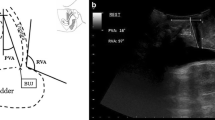Abstract
The effect of babies >3500 g primimultiparity, previous forceps deliveries, obesity and stress urinary incontinence on urethrovesical junction mobility (UVJ) was determined by the Q-tip test in 440 women divided into four groups according to age. The urethral axis under stress (UAS) for these different categories of patient compared to corresponding nulliparous patients (49°±21) demonstrates an increasing statistically significant difference in UVJ mobility in primiparas (56°±21), multiparas (58°±19), patients with previous forceps delivery (59°±21) and with deliveries of babies >3500 g (61°±17). Surprisingly, obesity does not affect UVJ mobility. Except for postmenopausal women, assessment of UAS in patients with GSI by history demonstrates a 5° higher UVJ mobility compared to continent patients (a 10° higher UVJ mobility was found in a fifth group of clinically proven GSI patients). When considering UAS distribution in the four groups, only 6%–33% of nulliparas have a ‘normal’ UAS of <30°, and 20% of young nulliparous patients have an UVJ hypermotility of >60°, demonstrating perhaps an increased risk of future GSI.
Similar content being viewed by others
References
Diokno AC, Brock BM, Brown D. Prevalence of urinary incontinence and other urologic symptoms in the noninstitutionalized patient. J Urol 1986; 136:1022–1026
Ouslander JC, Kane RL, Abrass IB. Urinary incontinence in elderly nursing-home patients. JAMA 1982; 248:1194–1196
Fantl JA, Wyman JF, McClicsh DK, Bump RC. Urinary incontinence in community-dwelling women: clinical, urodynamic and severity characteristics. Am J Obstet Gynecol 1990; 162:946–952
Crystle CD, Charme LS, Copeland WE. Q-tip test in stress urinary incontinence. Obstet Gynecol 1971; 38:313–315
Montz FJ. Stanton SL. Q-tip test in female uninary incontinence. Obstet Gynecol 1986; 67:258–260
Garrow JS, Webster J. Quetelet's index as a measure of fatness. Int J Obes 1985; 9:147–150
Green TH Jr. Development of a plan for the diagnosis and treatment of urinary stress incontinence. Am J Obstet Gynecol 1962; 83:632–635
Green TH Jr. The problem of urinary stress incontinence in the female. Obstet Gynecol Surv 1968; 23:603–606
Pelosi MA, Apuzzio JJ, Frattalora MA. A diagnostic device for stress incontinence. Obstet Gynecol 1975; 45:223–226
Karram MM, Bhatia NN. The Q-tip test: standardization of the technique and its interpretation in women with urinary incontinence. Obstet Gynecol 1988; 71:807–811
McCarthy TA. Urogynecology and urodynamics. Ostergard DR, Bent AE, (eds) Baltimore, Williams and Wilkins, 1991: 100
Walters MD, Diaz K. Q-tip test: a study of continent and incontinent women. Obstet Gynecol 1987; 70:208–211
Pregazzi R, Bouche C, Scrimin F, et al. Post-partum perineal evaluation. Role of the Q-tip test. Minerva Ginceol 1989; 41:493–495
Bergman A, McCarthy TA, Ballard CA, et al. Role of the Q-tip test in evaluating urinary incontinence. J Reprod Med 1987; 32:273–275
Richardson DA. Reduction of urethral pressure in response to stress: Relationship to urethral motility. Am J Obstet Gynecol 1986; 155:20–25
Walters MD, Shields LE. The diagnostic value of history, physical examination, and the Q-tip cotton swab test in women with urinary incontinence. Am J Obstet Gynecol 1988; 159:145–149
Wilkie DHL. Stress incontinence and obesity: a study of the effect on urethral function. Neurouro Urodyn 1987; 6:184–185
Asmussen M. Static and dynamic pressure of the lower urinary tract as measured by simultaneous urethral cystometry. Ostergard DR. (ed.) Gynecologic urology and urodynamics 2nd ed, Baltimore, Williams and Wilkins, 1985: 133–165
Koelbl H, Riss P. The significance of body mass index for genuine stress incontinence. Neurouro Urodyn 1987; 6:186–187
Fantl JA, Hurt G, Bump RC, et al. Urethral axis and sphincteric function. Am J Obstet Gynecol 1986; 155:554–558
Gordon D, Pearce M, Norton P, et al. Comparison of ultrasound and lateral chain urethrocystography in the determination of bladder-neck descent. Am J Obstet Gynecol 1989; 182–185
Versi E, Cardozo L, Studd J. Distal urethral compensatory mechanisms in women with incompetent bladder neck who remain continent, and the effect of the menopause. Neurourol Urodyn 1990; 9:579–590
Bergman A, Koonings PP, Ballard CA. Negative Q-tip test as a risk factor for failed incontinence surgery in women. J Reprod Med 1989; 34:193–197
Author information
Authors and Affiliations
Rights and permissions
About this article
Cite this article
Meyer, S., De Grandi, P. & Schmidt, N. The urethral axis during stress. Int Urogynecol J 4, 14–18 (1993). https://doi.org/10.1007/BF00372802
Issue Date:
DOI: https://doi.org/10.1007/BF00372802




